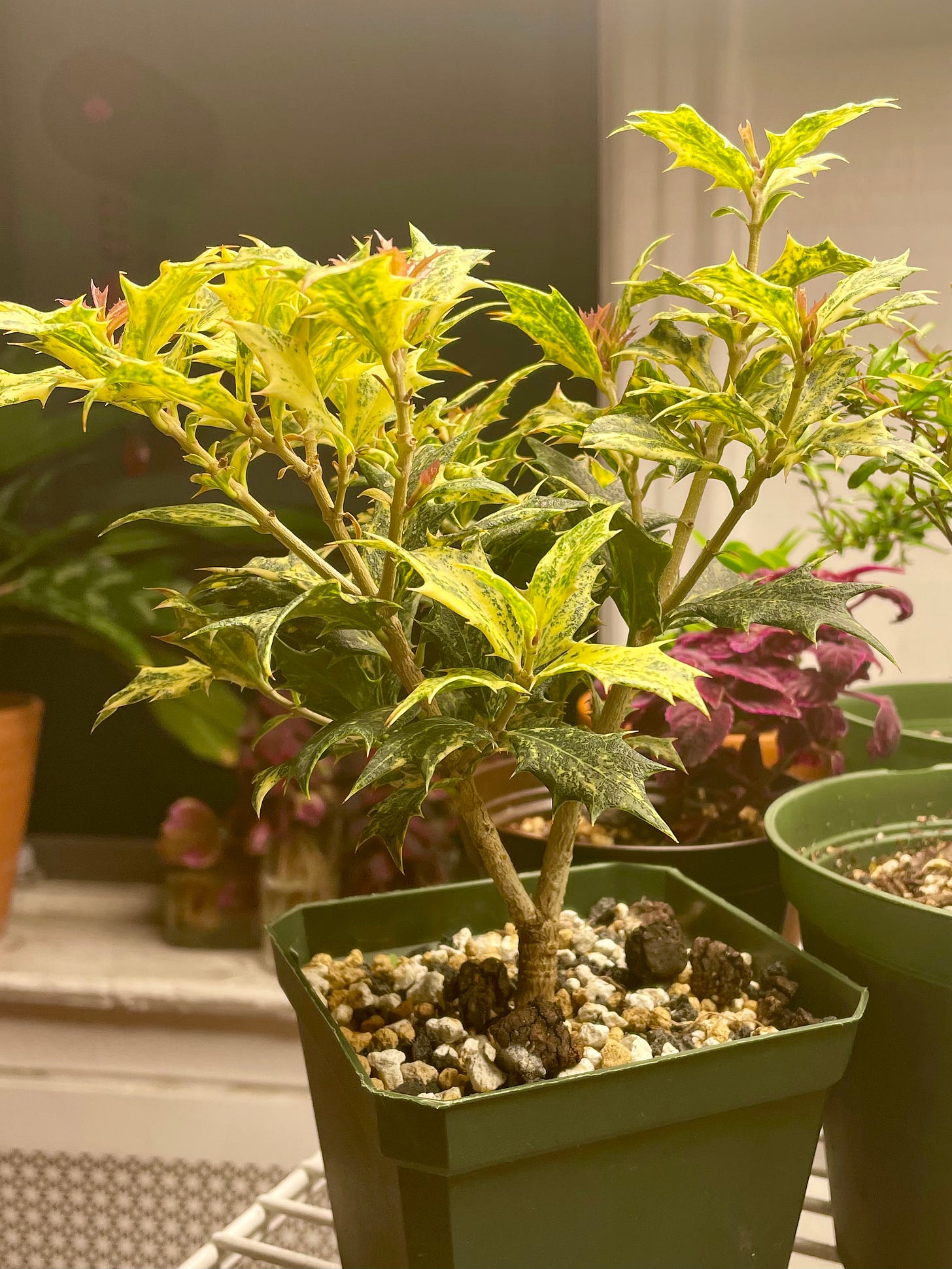I ran into this osmanthus last November, when the plant shop in my neighborhood set it out as part of their Christmas display. Osmanthus heterophyllus leaves are spiny to discourage animals from nibbling on them. The same spiny leaf trait is found in Ilex aquifolium, the Christmas holly; apparently this is good enough reason for the gardening industry to cross-promote the species. As such, O. heterophyllus is commonly referred to as false holly, which I think is rude.
Christmas aside, I had my eye on this species for a while, particularly the goshiki cultivar, which has this groovy variegation. O. heterophyllus is a member of the olive family and is said, like the olive, to be hardy and tolerant of abuse. It’s native to Taiwan, one of my favorite places, and southern Japan, a place I’d like to visit some day if the virus that won’t leave ever gets over itself. The flowers of its cousin, O. fragrans, are used to scent tea. O. heterophyllus flowers aren’t as impressive, I’m told, but plenty fragrant in their own right.
The plant shop was selling these baby shrubs for $15. None were especially good for bonsai. This one had a decent trunk with taper at least. I thought about it for two seconds and decided, why not? So now I have one. It could probably thrive with my outdoor trees, but my interest is in keeping it with my subtropicals. I can’t find hard information on its chill hour requirements. Given the climate of its native range, I’m guessing it doesn’t need a harsh winter to thrive.
In truth I have little attachment to this tree. It will probably die or stall out. Should it survive, it won’t look like anything for years, if ever. I consider it one of my experimental plants: ones I enjoy on a superficial level but mainly keep around to learn from them.
This is encouraging to me. I really care about some of my trees, and I’m glad I do. But they’ve also caused me heartbreak. I can’t do that with all my plants and I don’t want to.
For a year I’ve struggled to articulate what it is about caring for plants that’s different from pets or people, because of course it’s different, but there’s still a meaningful intimacy and exchange. I’m starting to think that the plant relationship isn’t really about any one plant. That maybe it’s a diffused aura thing, how you act and feel and learn around your plants and others’. Some will make an impact, some are just part of the ride.
Maybe. I don’t know. Please share your thoughts. Point being, I hope that this shift in my feelings is a sign of maturation, to not care with your whole heart all the time. This is much easier to do with plants than pets or people. In general I am trying to make less of a big deal of everything. It’s a struggle.
The osmanthus came through winter well. You can see some leaf burn in the photo above: damage from a few bitterly cold nights. That damage won’t heal, but the leaves still seem to be active. A hardy species indeed.
A few weeks ago I arbitrarily decided the tree had seen enough dormancy and was ready to be repotted from soggy nursery soil into airy inorganic bonsai mix. I bought this mix from a private seller on Facebook, as there are certain bonsai tasks I don’t want to try in this apartment and one of them is sifting pumice stone particles to a uniform one-eighth inch. The mix contains equal amounts of lava rock, pumice, and akadama, a Japanese fired-clay material often used in bonsai. All the pointy pebbles should encourage the tree’s roots to bifurcate and ramify. The stronger your roots, the stronger your foliage.
This week the tree started popping buds, a sign that it’s likely accustomed itself well to its new soil. True to the cultivar’s description, the new leaves emerge a glossy fuchsia. They’ll turn that speckled yellow-and-green pattern as they age. I won’t fuss with this tree for the rest of the season except to refresh the fertilizer. It’ll grow and I’ll watch it and maybe learn something. I’ll hate to see it go but I love to watch it leaf.
Tree reading
Spend some time with “Ghosts on a Tree,” a painting from 1933 by Franz Sedlacek. [Literary Fictions]
Jaleesa Jue planted 5,000 flowers in her Bronx neighborhood, elite New Yorker behavior. [Tiktok]



Well, there's a surprise. My wife, who follows Doctors a soap on BBC 1, asked me stop commenting on the latest edition and go look at my Bonsai and leave her in peace. Grumbling I wandered around the garden mumbling and generally prodding trees already bruised and mumbled at a few short hours earlier. Amongst this lot are four pots with Osmanthus plants that are rigidly defying growth or indeed any form of entertainment in the world of plants that grow. Oh sure they do have fine trunks and good root form but apart from that they remain stubbornly static. So I know how you must be feeling. By the way I did return to the program but failed to keep my mouth shut. Hey Ho.